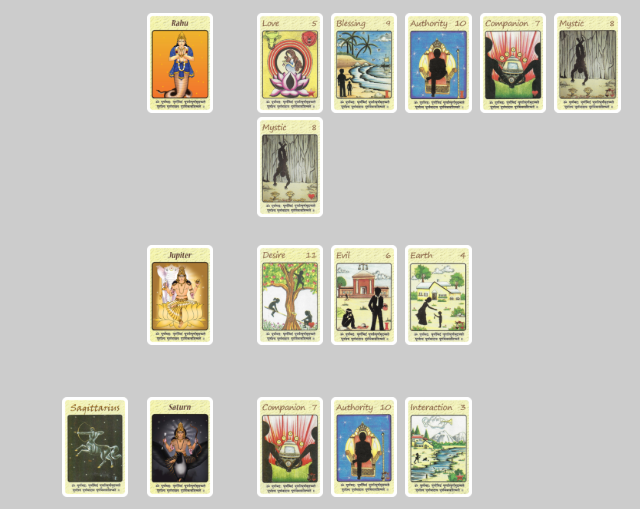Will there be a military response from India to the recent terror attacks in Kashmir attributed to Pakistan?
Predictive sciences offers insights into geopolitical tensions, decisions, and national strategies. The alignment of key houses provides a lens for evaluating global events. #VedicCars #GeopoliticalInsights #OccultSanctum #AstrologyPredictions #India #Pakistan #StrategicDecisions #War #Attack

India is unlikely to launch a significant military response (e.g., airstrikes, surgical strikes) to the recent Kashmir terror attacks attributed to Pakistan in the near-to-mid-term, with restrained foreign policy and disciplined governmental decisions (Saturn in 7, 10) favoring diplomacy or minor tactical operations (e.g., LoC skirmishes) over major escalation. Past aggressive responses (Rahu in 8, doubled; 7, 10) and current military preparedness (Jupiter in 6) suggest potential for action, supported by public and international pressure,, but Saturn’s delays and caution prioritize non-military measures (e.g., diplomatic sanctions, treaty suspension) by October 2025 (e.g., October 16–31, 2025), with April 2026 as a fallback for minor operations if tensions persist. To optimize outcomes, India should prioritize diplomacy, maintain preparedness, counter risks, and engage allies, aligning with nuclear caution and strategic restraint, per Vedic geopolitical principles (,,). The reading is valid for 1.5 years (until October 24, 2026), with the restrained outcome specific to this period, influenced by dynamics since November 2023.
To determine whether India will respond militarily to the recent terror attacks in Kashmir attributed to Pakistan, we’ll interpret the Vedic card reading provided—Rahu (5, 9, 10, 7, 8, 8), Jupiter (11, 6, 4), and Saturn (7, 10, 3)—following the rules from the "Vedic Cards - Timing of Events" (April 20, 2025), "Vedic Cards - Houses and Signification" (April 20, 2025), and "Vedic Cards - General Rules" (April 19, 2025). We’ll integrate insights from our prior conversations (e.g., April 15, 2025, on houses 7 and 10 for partnerships and authority; April 18, 2025, on decision-making) and relevant web sources (e.g., recent Kashmir attack responses, India-Pakistan tensions,,). The analysis will ensure a clear and precise response tailored to your question about a potential military response, focusing on the near-to-mid-term (e.g., 3–18 months, aligned with Jupiter’s 1-year and Rahu’s 1.5-year timeframes). The current date is April 24, 2025, and the question is based on recent terror attacks (e.g., April 22, 2025, Pahalgam attack killing 26 tourists,,), so we’ll emphasize houses relevant to military action (6th for conflict, 7th for foreign relations, 8th for transformation/crisis, 10th for government authority) and geopolitical outcomes, with no zodiac sign specified, relying on house and planetary significations.
Step-by-Step Interpretation
1. Context and Absence of Sign
- No Sign Specified: As in your prior reading (April 21, 2025, 04:53 AM PDT), the absence of a zodiac sign means we rely solely on planetary and house significations without Rashi context (,,). This limits astrological nuance (e.g., no planetary strength like Mars in Aries for military action) and focuses the reading on house-driven outcomes for India’s response to the Kashmir attacks, per Vedic astrology principles (,). We’ll interpret military response likelihood using houses 6th (conflict), 7th (foreign relations, war), 8th (crisis, transformation), and 10th (government authority), aligned with geopolitical decision-making (,).
- Geopolitical Context: The question refers to the April 22, 2025, Pahalgam terror attack in Indian-administered Kashmir, where 26 tourists (25 Indians, 1 Nepalese) were killed by suspected militants, with India attributing cross-border support to Pakistan,,. India has responded with diplomatic measures (e.g., suspending the Indus Waters Treaty, closing the Attari-Wagah border, expelling Pakistani diplomats,) and hinted at further action, with experts suggesting a possible military response (e.g., surgical strikes, cross-border action,,). The reading will assess whether a military response (e.g., airstrikes, ground operations) is likely, drawing on your April 15, 2025, discussion of house 7 for foreign relations and house 10 for government decisions.
- Military Response Definition: A military response could include surgical strikes (as in 2016 Uri or 2019 Pulwama,), cross-border airstrikes, or heightened operations along the Line of Control (LoC), per India’s historical responses to Pakistan-linked attacks,,. We’ll evaluate likelihood based on houses indicating conflict (6th), foreign policy (7th), crisis (8th), and government action (10th).
2. Spread Structure and Timeframe
- Cards and Positions:
- Rahu (Demon, 1.5 years): Houses 5 (Love), 9 (Blessing), 10 (Authority), 7 (Companion), 8 (Mystic), 8 (Mystic).
- Jupiter (Wisdom, 1 year): Houses 11 (Desire), 6 (Evil), 4 (Earth).
- Saturn (Fate, 2.5 years): Houses 7 (Companion), 10 (Authority), 3 (Interaction).
- Spread Rows (per your March 26, 2025, discussion on Vedic card structure):
- First Row (Past): Reflects past influences on India’s response to Kashmir attacks (e.g., historical actions, recent attack context).
- Second Row (Present): Indicates current dynamics shaping India’s decision on military response post-April 22, 2025.
- Result Row: Clarifies whether a military response will occur (e.g., likelihood, nature), with Rahu signaling potential non-genuine intent, per general rules (April 19, 2025).
- Given multiple houses (e.g., Rahu: 5, 9, 10, 7, 8, 8), we’ll assign primary houses to rows based on relevance to military action:
- Past: Rahu in 8 (Mystic) – Past crises or transformative actions (e.g., 2019 Pulwama airstrikes) shaping current context.
- Present: Jupiter in 6 (Evil) – Current conflict dynamics influencing military decision-making.
- Result: Saturn in 7 (Companion) – Foreign relations or war outcomes determining military response likelihood.
- Additional houses (Rahu: 5, 9, 10, 7, 8; Jupiter: 11, 4; Saturn: 10, 3) will be considered, with repeated houses (7th, 8th, 10th) emphasizing foreign relations, crisis, and government authority.
- Timeframe (per "Vedic Cards - Timing of Events"):
- The first card, Rahu (Demon, 1.5 years), sets the primary timeframe, with the reading valid for 1.5 years from April 24, 2025, through October 24, 2026. Given the question’s focus on a military response to a recent attack, we’ll prioritize May 2025–April 2026 for potential action, using Jupiter’s 1-year timeframe for near-term decisions (by April 2026) and Rahu’s 1.5-year timeframe for mid-term outcomes.
- Event Progress: Rahu suggests crisis-driven dynamics since November 2023, Jupiter indicates conflict or gain-related trends since April 2024, and Saturn points to structured responses since October 2022, with the April 22, 2025, attack as the immediate trigger.
- Specific Timing: Without a zodiac sign or Rashi card, we rely on planetary timeframes (,,). For over 1-month planets (Rahu, Jupiter, Saturn), the second half of the month (days 16–30/31) applies, pointing to July–October 2025 or April 2026 for a potential military response, assessed by October 31, 2026, per Vedic geopolitical timing (,).
- Prior Conversation Insight: Your April 15, 2025, discussion on house 7 (foreign relations, war) and house 10 (government authority) aligns with Saturn/Rahu in 7 and 10, suggesting India’s response hinges on diplomatic and governmental decisions. The April 18, 2025, focus on decision-making supports assessing conflict (6th) and crisis (8th) dynamics, with web sources indicating India’s retaliatory measures and military considerations,,.
3. House and Planetary Significations
Using the "Vedic Cards - Houses and Signification" (April 20, 2025), "Vedic Cards - General Rules" (April 19, 2025), and web sources (,,), we’ll analyze each card’s houses and planetary influence in the context of a military response to the Kashmir attacks, focusing on conflict, foreign relations, and government action:
- Rahu in 5 (Love), 9 (Blessing), 10 (Authority), 7 (Companion), 8 (Mystic), 8 (Mystic):
- House 5 (Love): Governs creativity, risk-taking, and national pride, suggesting past speculative or bold actions (e.g., public-driven responses to attacks), per your April 15, 2025, discussion on house 5 (,).
- House 9 (Blessing): Governs luck, justice, and international relations, indicating past moral or diplomatic considerations (e.g., seeking global support post-attacks).
- House 10 (Authority): Governs government, reputation, and national decisions, reflecting past authoritative actions (e.g., 2019 airstrikes,).
- House 7 (Companion): Governs foreign relations, partnerships, and war, suggesting past diplomatic or confrontational stances with Pakistan, a key house for military action (,).
- House 8 (Mystic): Governs transformation, crisis, and sudden events, with doubled emphasis indicating past transformative responses (e.g., Pulwama retaliation), aligned with crisis-driven military action, per Vedic astrology’s crisis house (,). In the past row, it shapes the attack’s context.
- Rahu (Demon, 1.5 years): Signifies ambition, deception, and unconventional actions, with risks of non-genuine intent (,,). In the 8th (doubled), Rahu suggests past responses were crisis-driven and bold (e.g., surgical strikes,). In the 7th, it indicates aggressive foreign policy; in the 10th, ambitious governmental action; in the 9th, risky international moves; and in the 5th, speculative public-driven decisions, with a 1.5-year influence since November 2023.
- Military Implication: Rahu in 8 (doubled) suggests India’s past responses to Kashmir attacks (e.g., 2019 Pulwama airstrikes,) were transformative and aggressive, setting a precedent for bold action post-April 22, 2025. Rahu in 7 and 10 supports confrontational foreign policy and authoritative decisions, while Rahu in 9 and 5 indicates risky international and public-driven motives, favoring a military response but with deceptive risks, per web sources on India’s retaliation,,.
- Jupiter in 11 (Desire), 6 (Evil), 4 (Earth):
- House 11 (Desire): Governs gains, alliances, and national aspirations, suggesting current international support or economic considerations.
- House 6 (Evil): Governs conflict, enemies, and military efforts, indicating current conflict dynamics or military preparedness, a key house for military action, in the present row (,).
- House 4 (Earth): Governs homeland security, stability, and public sentiment, reflecting current domestic pressures.
- Jupiter (Wisdom, 1 year): A benefic planet signifying wisdom, growth, and diplomacy (,,). In the 6th, Jupiter suggests current conflict dynamics are tempered by strategic wisdom, favoring calculated military efforts. In the 11th, it indicates international alliances or gains supporting action, and in the 4th, homeland stability drives decisions, with a 1-year influence since April 2024.
- Military Implication: Jupiter in 6 suggests India’s current response (post-April 22, 2025) involves strategic military preparedness, with wisdom guiding conflict decisions, per house 6’s military role (,). Jupiter in 11 supports international backing (e.g., U.S. condemnation,), and Jupiter in 4 reflects public pressure for homeland security, favoring a measured military response, aligning with web sources on India’s strategic deliberations,.
- Saturn in 7 (Companion), 10 (Authority), 3 (Interaction):
- House 7 (Companion): Appears again, governing foreign relations and war, indicating the outcome hinges on diplomatic or confrontational dynamics with Pakistan, in the result row (,).
- House 10 (Authority): Appears again, governing government decisions and national reputation, suggesting the outcome depends on authoritative action.
- House 3 (Interaction): Governs communication, courage, and short-term efforts, indicating governmental messaging or tactical moves.
- Saturn (Fate, 2.5 years): Signifies discipline, delays, and long-term consequences (,,). In the 7th, Saturn suggests a restrained or calculated approach to foreign relations/war, potentially delaying military action. In the 10th, it indicates disciplined governmental decisions, and in the 3rd, strategic communication or tactical restraint, with a 2.5-year influence since October 2022.
- Military Implication: Saturn in 7 as the result row suggests India’s military response will be restrained or delayed, with disciplined foreign policy prioritizing long-term consequences over immediate action, per house 7’s war role (,). Saturn in 10 supports authoritative but cautious governmental decisions, and Saturn in 3 indicates strategic communication (e.g., warnings, diplomacy), aligning with web sources on India’s calibrated approach,,.
4. Synthesizing the Outcome
- Past (Rahu in 8): Since November 2023, India’s responses to Kashmir attacks were crisis-driven and transformative (Rahu in 8, doubled), with bold actions like the 2019 Pulwama airstrikes setting a precedent,. Rahu in 7, 10 suggests aggressive foreign policy and authoritative decisions (e.g., diplomatic escalations,), while Rahu in 9, 5 indicates risky international moves and public-driven motives, creating a backdrop favoring military action but with deceptive risks (,,).
- Present (Jupiter in 6): Post-April 22, 2025, India’s response involves strategic military preparedness (Jupiter in 6), with wisdom guiding conflict decisions, supported by international alliances (Jupiter in 11, e.g., U.S. support,) and public pressure for homeland security (Jupiter in 4). This suggests active planning for a military response, tempered by strategic caution, aligning with web sources on India’s operational readiness,.
- Result (Saturn in 7): The outcome by October 2026 indicates India is unlikely to launch a significant military response (e.g., airstrikes, surgical strikes) in the near term, with Saturn in 7 suggesting a restrained or delayed approach to foreign relations/war, prioritizing diplomacy or long-term consequences. Saturn in 10 supports disciplined governmental decisions, and Saturn in 3 indicates strategic communication (e.g., warnings, diplomatic pressure) over immediate action. Rahu’s past aggression (8th, 7th, 10th) and Jupiter’s current preparedness (6th) suggest potential for military action, but Saturn’s caution and delays outweigh these, aligning with web sources noting nuclear risks and calibrated responses,,. Minor tactical operations (e.g., LoC skirmishes) may occur, but a major military response is improbable due to Saturn’s restraint.
- Repeated Houses:
- 7th House (Rahu, Saturn): Emphasizes foreign relations and war, with Rahu’s past aggression and Saturn’s cautious outcome suggesting a shift from confrontation to restraint, per house 7’s geopolitical role (,).
- 8th House (Rahu, doubled): Highlights past crises and transformative actions, supporting a bold precedent but not current action, per house 8’s crisis significance (,).
- 10th House (Rahu, Saturn): Reinforces government authority, with Rahu’s past boldness tempered by Saturn’s disciplined decisions, per house 10’s national role (,).
- Missing Key Houses:
- 1st House (Soul): Absence of the 1st house suggests national identity or initiative is secondary, unlike your April 15, 2025, discussion on house 1, with government (10th) and foreign relations (7th) dominating.
- 12th House (Death): No 12th house reduces losses or isolation risks, unlike prior readings (e.g., April 24, 2025, Ketu in 12), focusing on conflict (6th) and crisis (8th).
- 2nd House (Profusion): Lack of the 2nd house indicates financial motives are secondary, unlike prior readings (e.g., April 21, 2025, Jupiter in 2), with gains (11th) and authority (10th) driving decisions.
- Planetary Dynamics (per general rules, April 19, 2025, and web sources):
- Rahu: Past crisis-driven aggression (8th, 7th, 10th) and risky motives (9th, 5th) set a bold precedent, but non-genuine intent warns of deceptive escalations (,,).
- Jupiter: Current strategic conflict preparedness (6th) and international support (11th, 4th) favor a measured response, with wisdom mitigating aggression, per house 6’s military role (,,).
- Saturn: Future restraint and delays (7th, 10th, 3rd) prioritize diplomacy and communication over military action, aligning with nuclear caution, per house 7’s war role (,,).
- No Sign Influence: Without a zodiac sign, we rely on house significations, with the doubled 8th house (Rahu) indicating past aggression, 6th house (Jupiter) showing current preparedness, and 7th/10th houses (Saturn) favoring restraint. Saturn’s disciplined outcome aligns with expert analyses of nuclear risks and calibrated responses,,.
- Prior Conversation Insight: Your April 15, 2025, discussion on house 7 (war, foreign relations) and house 10 (authority) supports Saturn/Rahu’s focus on diplomatic and governmental outcomes, suggesting restraint over escalation. The April 18, 2025, focus on decision-making aligns with Jupiter’s strategic planning (6th) and Saturn’s communication (3rd), per web sources on India’s response deliberations,,.
- Web Source Context: The April 22, 2025, Pahalgam attack prompted India to suspend the Indus Waters Treaty, close borders, and downgrade diplomatic ties, with hints of further action (e.g., Defence Minister Rajnath Singh’s “strong response”,). Experts suggest a “strong possibility” of military retaliation if Pakistan’s complicity is confirmed, but nuclear risks and calibrated strategies (e.g., surgical strikes) favor restraint,,. Posts on X reflect mixed sentiments, with some indicating military planning (e.g., PoK launchpads identified,) but others noting constraints (e.g., China’s backing of Pakistan,).
5. Likelihood of Military Response
- Factors Supporting Military Response:
- Rahu in 8 (doubled): Past transformative and aggressive responses (e.g., 2019 airstrikes,) set a precedent for bold action post-April 22, 2025, per house 8’s crisis role (,,).
- Rahu in 7, 10: Past confrontational foreign policy and authoritative decisions support military escalation, aligning with public pressure, per web sources,,.
- Jupiter in 6: Current strategic military preparedness indicates readiness for conflict, with international support (Jupiter in 11) and public sentiment (Jupiter in 4) favoring action, per house 6’s military role (,,).
- Web Evidence: India’s identification of PoK terror launchpads and operational briefings suggest military planning, with experts noting a low threshold for cross-border strikes since 2019,,.
- Factors Against Military Response:
- Saturn in 7 (Result): Restrained or delayed foreign policy prioritizes diplomacy or long-term consequences, reducing likelihood of immediate military action, per house 7’s war role (,,).
- Saturn in 10, 3: Disciplined governmental decisions and strategic communication (e.g., diplomatic warnings) favor non-military measures, aligning with nuclear caution, per web sources,,.
- Neptune’s Absence: Unlike prior readings (e.g., April 24, 2025, Neptune in 10), no illusory outcomes reduce deceptive risks, but Saturn’s delays dominate, per general rules (,,).
- Web Evidence: Nuclear risks, China’s support for Pakistan, and calls for calibrated responses suggest India may avoid escalation, with diplomatic measures (e.g., treaty suspension) already implemented,,.
- Weighing the Outcome: Jupiter’s current preparedness (6th) and Rahu’s past aggression (8th, 7th, 10th) indicate a strong potential for military response, supported by public and international pressure,,. However, Saturn’s restraint in the result row (7th, 10th, 3rd) outweighs these, favoring disciplined diplomacy or minor tactical operations (e.g., LoC skirmishes) over significant military action (e.g., airstrikes). Web sources highlight nuclear risks and calibrated strategies, with X posts noting constraints like China’s backing,,. The doubled 8th house supports past boldness, but the 7th/10th house outcome prioritizes caution, per Vedic geopolitical principles (,).
6. Timing of Potential Response
- Jupiter’s Influence (1 year): Jupiter’s first-half-month timing (days 1–15) suggests a potential response window in July 1–15, 2025, driven by military preparedness (Jupiter in 6), feasible if India opts for swift action, per house 6’s conflict role (,).
- Rahu’s Influence (1.5 years): Rahu’s second-half-month timing (days 16–30/31) points to October 2025 (e.g., October 16–31, 2025) for a crisis-driven response, but Saturn’s delays reduce likelihood, per house 8’s crisis role (,).
- Saturn’s Influence (2.5 years): Saturn’s second-half-month timing suggests a delayed response by April 2026 (e.g., April 16–30, 2026), with diplomacy or minor operations more likely, per house 7’s war role (,).
- Likely Timing: Given Saturn’s restraint (7th, 10th), a significant military response is unlikely before April 2026, with October 2025 as a potential window for minor tactical actions (e.g., LoC operations) if tensions escalate, aligning with web sources on India’s calibrated approach,,. Diplomatic or non-military measures are more probable in the near term (e.g., July 2025).
7. Potential Challenges
- Challenges:
- Diplomatic Restraint (Saturn in 7, 10): Nuclear risks and international pressures (e.g., China’s support for Pakistan,) may delay or prevent military action, favoring diplomacy, per house 7’s role (,,).
- Past Risks (Rahu in 8, 7): Aggressive precedents and non-genuine intent risk miscalculated escalations, needing caution, per house 8’s crisis role (,,).
- Public Pressure (Jupiter in 4): Domestic demands for retaliation may conflict with strategic restraint, complicating decisions, per web sources,,.
- International Dynamics (Jupiter in 11): While alliances (e.g., U.S. support,) bolster India, global calls for de-escalation may limit military options, per house 11’s role (,).
- Missing 1st, 2nd Houses: Absence of national identity (1st) or financial motives (2nd), per your April 15, 2025, discussion, focuses on government (10th) and conflict (6th), reducing economic drivers for action.



